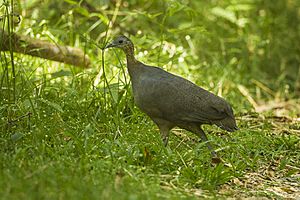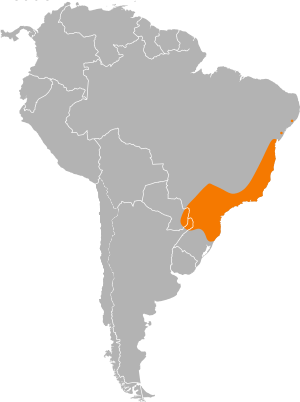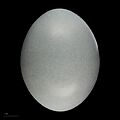Solitary tinamou facts for kids
Quick facts for kids Solitary tinamou |
|
|---|---|
 |
|
| At Intervales State Park, São Paulo, Brazil | |
| Conservation status | |
| Scientific classification | |
| Genus: |
Tinamus
|
| Species: |
solitarius
|
 |
|
| Synonyms | |
|
Cryptura solitaria (Vieillot) |
|
The solitary tinamou (Tinamus solitarius) is a special type of ground bird. It is known for living mostly on the ground, even though it can fly short distances. This bird is originally from the Atlantic forest in eastern Brazil.
Contents
What is a Solitary Tinamou?
All tinamous belong to the bird family called Tinamidae. They are also part of a larger group known as ratites. Ratites are birds that usually cannot fly, like ostriches or emus. However, tinamous are different because they can fly, even if they are not very strong flyers. Scientists believe that all ratites came from ancient flying birds. Tinamous are the closest living relatives to these old flying birds.
Different Kinds of Solitary Tinamous
In the past, people thought there were two different types (subspecies) of solitary tinamous. One was found in northeast Brazil, and the other in southeast Paraguay and northeast Argentina. But later, scientists found out that these were not truly different types. Instead, they were just individual birds with slightly different colors. For example, the color of their back can be olive or rusty. Also, the color of their lower neck can vary in how strong it looks. Some birds have more black stripes in these areas.
Appearance: What Does It Look Like?
The solitary tinamou is a large bird, about 45 centimeters (18 inches) long. It is mostly brownish with many black stripes. Its neck, chest, and sides are grey, and its belly is white. The top of its head is dark brown, and its throat is white. It also has a clear buff-colored line on the side of its yellowish head and neck.
Where Do Solitary Tinamous Live?
This bird lives in several states in southeastern Brazil, including Bahia, Minas Gerais, Espírito Santo, Rio de Janeiro, São Paulo, and others. You can also find it in southeastern Paraguay and a small part of northeastern Argentina.
Behavior and Life Cycle
Like other tinamous, the solitary tinamou lays eggs that have a unique shape and a shiny, colorful shell. These birds mostly eat fruits and seeds that they find on the ground or on low plants.
Parenting Habits
When it's time for the eggs to hatch, the male tinamou takes care of them. He sits on the eggs in a nest built on the ground. After the chicks hatch, the male also looks after them for a short time until they are old enough to live on their own.
Habitat and Environment
The solitary tinamou lives in humid tropical forests and mountain forests up to 1,200 meters (about 3,900 feet) above sea level. It can live in forests that have grown back after being cut down. It can even handle some logging, which is when trees are cut down. However, they do not like large farms with non-native plants.
These birds can still be found in areas where people have small farms mixed with new forest growth. They like places with dense plants like caeté and bamboo. Even in small forest areas, as tiny as 400 hectares (about 1,000 acres), these birds can live and thrive if the forest is not too disturbed.
Conservation: Protecting the Solitary Tinamou
The solitary tinamou is currently facing threats. Its home is being destroyed because of cities growing, new factories, farms expanding, and roads being built. People also hunt these birds too much. Because of these problems, the IUCN (International Union for Conservation of Nature) lists the solitary tinamou as a Near Threatened species. This means it might soon become vulnerable to extinction. Its living area is about 990,000 square kilometers (382,000 square miles).
The group of tinamous that used to be called pernambucensis in the north is now very rare, or might even be gone. These northern birds have always been quite rare throughout history.
Helping the Solitary Tinamou
It has been noticed that it's not too hard to move solitary tinamous to new, suitable places. For example, some solitary tinamous were found to live well in a forest area of 1,500 acres (about 600 hectares) where they didn't originally live. This shows that with help, their populations can grow in new homes.
Images for kids
See also
 In Spanish: Macuco para niños
In Spanish: Macuco para niños





